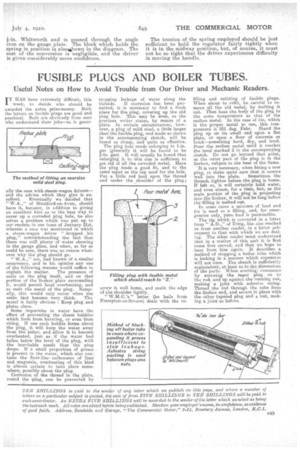FUSIBLE PLUGS AND BOILER TUBES.
Page 39

If you've noticed an error in this article please click here to report it so we can fix it.
Useful Notes on How to Avoid Trouble from Our Driver and Mechanic Readers.
I T HAS been extremely difficult, this week, to decide who should be awarded the extra prize-money. Roth the letters on fusible plugs are good and practical. Both are obvioesly from men who understand their jobs—as is gener
ally the case with steam-wagon drivers— and the advice which they give is ex cellent. Eventually we decided that "WA," of Stratford-on-Avon, should have it, because, in addition to giving an excellent hint as to the best way to cover up a corroded plug hole, he also solves a problem which was put up to our readers in our issue of January 31st, wherein a case was mentioned in which a steam-wagon driver " dropped his plug," notwithstanding the fact that there was still plenty of water showing in the gauge glass, and when, so far as could be seen, there was no reason whatever why the plug should go.
" W.A.," too, had known of a similar occurrence, and in his opinion any one of the following reasons would suffice to explain the matter. The presence of scale on the plug itself, and on that portion of the firebox plate surrounding it. would permit local overheating, and so melt the metal of the plug. Naturally, this would only occur when the scale h/ad become very thick. The moral is fairly obvious : Keep plug and plates clean.
Some impurities in water have the effect of preventing the aleam bubbles which form from bursting, or even from rising. If one such bubble forms about the plug, it, will keep the water away from the latter, and allow it to become overheated, just as if the water had fallen below the level of the plug, with the inevitable result that the plug drops. If a small proportion of grease is present in the water, which also contame the flour-likecarbonates of lime and magnesia, overheating of this ldnd is almost certain to take place somewhere, possibly about the plug. Corrosion of the thread in the plate, round the plug, can be prevented by stopping leakage of water along the
threads. If corrosion has been permitted, it is necessary to find a fresh place for the plug, covering up the old plug hole. This may be done, as the previous writer states, by means of a plate. In certain circumstances, however, a plug of mild steel, a little larger than the fusible plug, and made as shown in the accompanying sketch, will be found as cheap, and quite as effective.
The plug hole needs enlarging to 1-in. gas (generally it will be found to be i-in. gas). It will usually be found that enlarging it to this size is sufficient to get rid of all the corroded metal_ Have the plug made a good fit, and to the same taper as the tap used for the hole. Put a little red lead upon the thread and under the ,shoulder of the plug; filling and refitting of fusible plugs. When about to refill, he careful to remove all the old metal, by melting it out. Then heat the body of the plug to the same temperature as that of the molten metal. In the case of tin, which is the proper metal to use, this temperature is 551 deg. Fahr. Stand the plug up on its small end upon a flat plate, or upon a floor of concrete or brick—something hard, dry, and level. Pour the molten metal until it reaches the level marked 2 in the accompanying sketch. Do not go beyond that point, as the outer part of the plug is in the firebox, subject to the heat of the flame. It is very necessary, when fitting a new plug, to make quite sure that it screws well into the plate. Sometimes the threads tighten before the plug is home. If left so, it will certainly hold water, and even steam, for a. time, but, as the main portion of the plug is projecting into the firebox, it will not be long before the filling is melted out. In some cases a mixture of lead and tin is used as a filling, and, for emergencies only, pure lead is permissible. The tip which is conveyed in a letter from " A.D.," of Tring, has also reached us from another reader, in a letter subsequent to that with which we are dealing. The other reader must understand that in a matter of this sort it is first come first served, and that we hope to hear from him again. It describes a method of stopping a boiler tube which is leaking in a manner which expansion will not cure. The sketch is sufficiently explanatory, at least as to the dimensions of the parts. When erecting: commence by screwing the taper plug on to the rod-, and up against the running nut, making a joint with asbestos string. Thread the rod through the tube from the firebox end, and secure in place with the other tapered plug and a nut, making a joint as before.








































